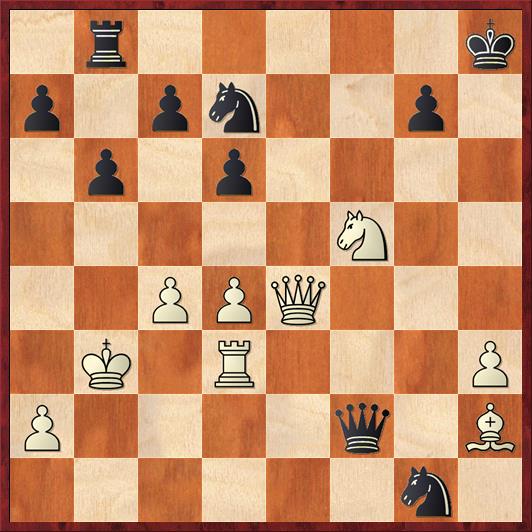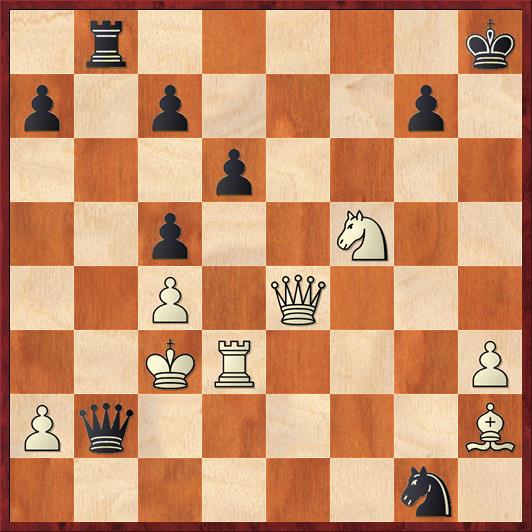Today’s trivia: Name a person who has been the chess champion of both Connecticut and Norway.
Today’s quiz: Black to play and win.
 Position after 28. Qe4. Black to move.
Position after 28. Qe4. Black to move.
FEN: 1r5k/p1pn2p1/1p1p4/5N2/2PPQ3/1K1R3P/P4q1B/6n1 b – – 0 28
The quiz and the trivia question are actually related to each other, because the player of the Black pieces is the answer to the trivia question.
In one of those coincidences that come with writing a blog, I recently received a list of Connecticut state champions from Bob Cyr, the Connecticut State Chess Association historian. Thanks, Bob! One of the names on the list was familiar, both because he was active when I was just starting out in chess, and because I had just looked at a game of his! The name is Jonathan Tisdall.
Tisdall is a grandmaster who, according to Wikipedia, grew up in the U.S. but emigrated to Ireland and later to Norway. Smart guy! In the event of a zombie apocalypse, or a meltdown of the ice sheets, or Donald Trump becoming dictator for life in the U.S., Norway is the first country I would choose as a refugee. But I would probably be too late. They would probably pass a law keeping Americans out.
Anyway, it’s odd that I never really thought of Tisdall as an American player. I would have thought that he was a British grandmaster. So I was surprised to see that he started his career playing the other greats of the 1970s in American chess, like Mark Diesen, Ken Regan, Michael Rohde, Jim Tarjan, etc. His earliest game at chessgames.com was in 1973, against Elliott Winslow, who is still active in the Bay Area. My best guess is that Tisdall left for the U.K. around 1979-80, because there is a gap in his games in ChessBase around that period. Does anyone know?
The position above is from a game he played in the 1988 Norwegian championship against Joran Jansson, who was playing White. I was interested in it because Jansson played an opening variation, 1. d4 Nf6 2. c4 e6 3. Nc3 Bb4 4. Bf4?!, that I’ve experimented with a little bit. He went off the rails around move 12, so I’m not sure there is much to learn about the opening. But the finish was really cute. In the diagrammed position, Tisdall sprung the piece sacrifice 28. … Nc5+! 29. bc bc+ 30. Kc3 Qb2 mate!
FEN: 1r5k/p1p3p1/3p4/2p2N2/2P1Q3/2KR3P/Pq5B/6n1 w – – 0 31
Yes, it really did go to mate, which tells me either that White was in time pressure or he actually didn’t see the mate. It does come a little bit out of nowhere. Until the last move Black’s rook wasn’t even participating in the attack, and now it suddenly plays a key supporting role.
I thought this was a great teaching example and showed it to my kids in chess club yesterday. Here are some of the things I pointed out:
“In-your-face” checks and checkmates. Not only the one that actually happened, but also in the side lines 30. Ka3 Qb2+ (in your face!) 31. Ka4 Qb4 mate (in your face!). The latter is more typical than the one that happened in the game. The kids need constant reinforcing on it, because they have so many games when they can’t figure out how to checkmate with a queen and rook, even when it’s mate in one.
“Walk-the-dog” checkmates. After 30. Ka4 Qxa2+ 31. Ra3 Rb4+ 32. Ka5 Qxa3 mate we see the other common queen and rook checkmate pattern. I think it’s good for the kids to see that it’s not useful only in the endgame, but can also arise in the middle game.
Keeping the initiative. The checkmate is cute and all that, but can’t Black also win just by grabbing a free piece with 28. … Qxh2? The answer is no: After 29. Qg4! White has a winning attack; if 29. … Rg8 then 30. Qh5 mate, or if 29. … Nc5+ now White can simply step aside with 30. Ka3. Black has to defend with 30. … Ne6. After that, 31. Qh5+ Kg8 32. Ne7+ should be decisive. This was a little bit too hard for the kids to see. But one of them did make a cool suggestion — 29. Ne7 instead of 29. Qg4. I really liked the thought process behind this move, because White is trying to close the mating net first, before he starts checking. Very sophisticated idea! Unfortunately, it runs into the same trap as in the game: 29. Ne7?? Nc5+, and even if it weren’t for that possibility, Black could also play defensively with 29. … Nf6 with at least a draw. But I didn’t mention that because I wanted to give the student positive reinforcement (Ne7! Good idea!) instead of criticism.
Was I guilty of sugar-coating the lesson there at the end? There are no moral victories in chess. You can have a great thought process but if you miss some stupid tactical trap, you lose the game. Or is it okay, as a teacher, to leave one truth unspoken in order to reinforce another truth? Maybe it’s okay to allow moral victories in the classroom even if you know they don’t happen in real life? Opinions, please!
Also, if anybody has any memories of Jonathan Tisdall, please feel free to contribute them. (Elliott Winslow, are you there?)




{ 9 comments… read them below or add one }
I’m reminded of a comment you made a while back, that playing Shredder set to too-high difficulty was simply teaching you that sacrifices and combinations don’t work. I have seen the same effect when a very strong player is analyzing with or playing with a weaker one. So no, I don’t think you were doing your students a disservice by not showing everything you could see.
4. Bf4 against Nimzo-Indian seems completely out of place.
Tony Miles developed 4. Bf4 against the Queen Indian and had some decent results with it, until it was discovered that 4. … Bb4+! completely neuters it. Geller gives 5. Nfd2 as the best move but Black is at least equal, and according to him, in case of 5. Nc3 5. … Ne4 overtakes the initiative, as the bishop may be harassed by the black’s g and h pawns.
I played 4. Bf4 maybe 3-4 times in tournaments. Probably the main idea I had was that if Black plays an unwary … c5 I might be able to play Bd6. However, none of my Black opponents ever fell for this, and in fact the problem I repeatedly had to face was that after … d6 White is not able to hold back … e5 forever (winning a tempo and basically equalizing on the spot).
I’ve always wanted to create a descriptive language of chess, which is pretty limited: fork, pin, x-ray, smothered mate, Dana’s hook and ladder, etc. American football has a rich variety of play calls that summarize what each player has to do.
In Dana’s article, I see three descriptors:
– black knight commits forced suicide on c5
– b6 pawn opens a tunnel door for his rook
– white king is trapped in the tunnel (cue guitar music from Third Man theme)
Maybe someday I’ll be able to describe an entire game solely by using such descriptive themes, like a radio announcer calling a play-by-play.
I wonder if there is an alternate computer chess universe where the computer could play a chess game not with brute calculations but by searching for such themes. Imagine if computer power was stuck in 1970; programmers would have had to find other ways of playing chess than mere brute force calculation. So in a sense, advances in hardware have prevented the emergence of elegant algorithms.
Why, the symbol language of the Chess Informant does a significant part of the job. The Informants have no words besides the tournament metadata yet each game if quite fully annotated by the symbols.
Tisdall’s book Improve Your Chess Now is quite good, though apparently out of print. He’s on Twitter as @GMjtis.
Hi Dana,
Dan Schmidt got in touch via Twitter about your blog, and this is a good time to correct the Wikipedia entry. I emigrated to London after leaving the US in December 1980, then to Norway in 85/86, where I’ve been since. The Wiki confusion is certainly due to my dual citizenship, I carry US and Irish passports.
It’s funny, I don’t remember winning the Connecticut championship – I do remember becoming NY State champion unexpectedly early in life.
Finally, Norway is indeed a good place to face climate change or zombie apocalypses. Bit quiet otherwise though.
Jonathan, thanks for the information, and welcome to the blog!
Bob’s list of Connecticut state champions has you as the co-champion in 1979 with Eric Godin. Does that jog any memories?
New York state champion is a more impressive accomplishment, but my favorite trivia question about that state is: What World Champion was also a New York state champion? I’ll bet most people would guess Bobby Fischer, but actually it was Jose Capablanca (1910).
I, too, like that book. And it says something positive about Ray Keene, a seeming rarity in the chess world (one of John Watson’s semi-recent books did, as well).
(Hi, dfan!)